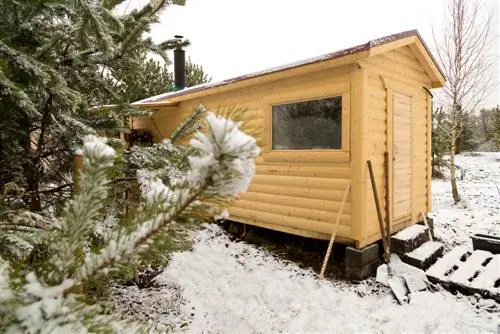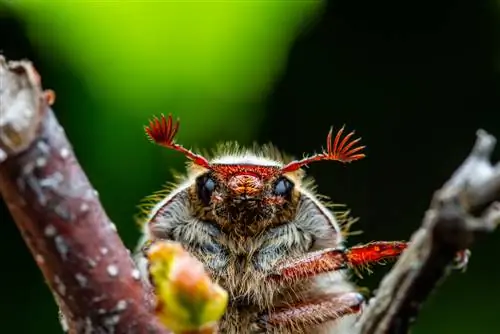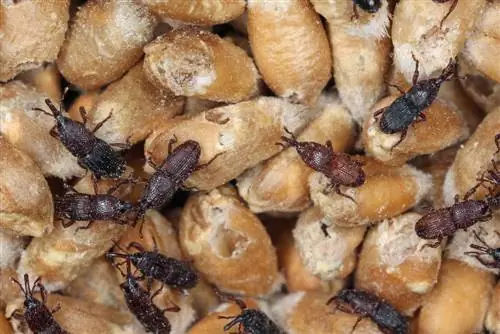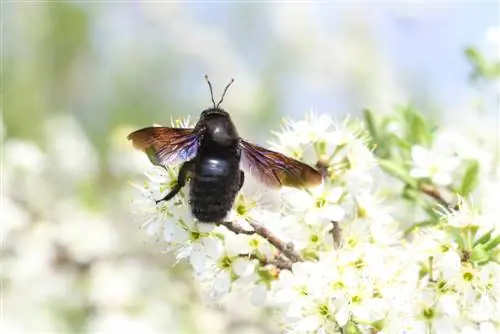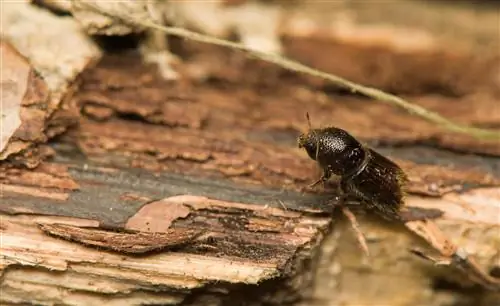- Author admin [email protected].
- Public 2023-12-16 16:46.
- Last modified 2025-01-23 11:22.
Many small black beetles in the house and garden raise questions. Is it a serious pest infestation, a visit from long-awaited beneficial insects or a flying visit? An expert identification of the beetle species provides the answer. This guide introduces you to common black beetles with pictures and useful identification tips.

What little black beetles are there in the house and garden?
Small black beetles in the house can be grain beetles, flour beetles, fur beetles, house longhorn beetles or black bacon beetles. In the garden, however, you can often find black weevils, timber bark beetles, Asian lady beetles, rapeseed beetles and black water jumpers. These types of beetles are harmless and do not bite or sting.
- Common small black beetles in the house are: grain beetles, flour beetles, fur beetles, house longhorn beetles and black bacon beetles
- Small black beetles in the garden go by the names black weevil, timber bark beetle, Asian lady beetle, rapeseed beetle and black water skipper.
- Small black beetles cannot bite or sting and are not poisonous to humans.
Identifying small black beetles in the house
Are little black beetles just paying a quick courtesy visit to your home or do you have a pest problem on your hands? The answer to the question is a correct identification of the beetle species. The following table provides initial clues to the identity of five common black beetles in the home:
| Little black beetles indoors | grain beetle | Flour Beetle | fur beetle | Hausbock | Black bacon beetle |
|---|---|---|---|---|---|
| Size | 2-4 mm | 10-18mm | 3, 5-6 mm | 8-26mm | 7-9mm |
| Body shape | long stretched | long stretched | elongated oval | slim | twice as long as wide |
| Flyable yes/no | no | yes | yes | yes | conditionally |
| Where to find? | in the kitchen | in the flour, in the kitchen | in the room/in the closet | in wood, in furniture | in the house, in supplies |
| Special feature | long trunk | Cover wings with longitudinal grooves | with white dots | with 2 pairs of white dots | dark hairy |
| Botanical name | Sitophilus granarius | Tenebrio molitor | Attagenus pellio | Hylotrupes bajulus | Dermestes ater |

The following short portraits provide in-depth information about the five most common black beetle species in the house.
Grain beetle (Sitophilus granarius)
When fully grown, grain beetles are still tiny. It takes a magnifying glass to locate the long trunk as an extension of the head with a strong mouthpart. The black body is elongated and decorated with distinctive grooves and bright dots. There are no longer functional wings under the cover wings.
- Where to find it: in the kitchen on all kinds of grains, preferably rye, on pasta, in dried vegetables
- When to find: all year round
Flour beetle (Tenebrio molitor)

Four beetles, true to their name, are often found in flour
From the black beetle family, the tiny flour beetle has specialized in human supplies that contain plenty of starch. Bakeries have declared the nocturnal black beetle their number one enemy. Curved, black cover wings with longitudinal grooves and reddish-brown legs reveal the name of the stored product pest.
- Where to find it: in flour, grain and baked goods
- When to find: all year round
Fur beetle (Attagenus pellio)
The fur beetle is unpopular in apartments and warehouses because its larvae eat textiles, fur, dried meat, sausage and dog food. The elongated-oval black beetle is densely hairy and has three light hairy spots on the pronotum, in addition to white dots on the wing coverts.
- Where to find indoors: in living rooms, pantries, in wardrobes
- When to find: all year round in the house, from April to September in the garden
House buck (Hylotrupes bajulus)
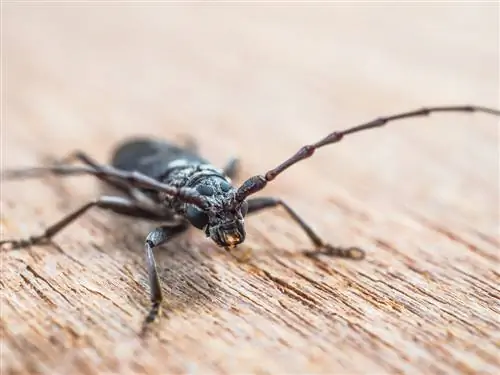
The house buck causes a lot of damage to wooden furniture
If elongated, black beetles appear in the home with long antennae, white dots and two bulges in the pronotum, there is justifiable cause for concern. Another clue to the profile of the wood pest is lighter antennae and legs. The highest priority for control measures is when piles of drill dust are found in the house because house borers and larvae eat through the wood of the roof structure or furniture.
- Where to find inside: in the house, in the wood
- When to find: all year round
Excursus
Little black beetles or cockroaches?
If dark beetle figures scurry around your apartment at night, you should not take the encounter lightly. Cockroaches look very similar to small black beetles. Because the beasts sprint through the house at top speed, the frightened observer misses important clues about the actual identity of the dangerous pests. German cockroaches (Blattella germanica) and Oriental cockroaches (Blatta orientalis) love warm, humid conditions in the bathroom, basement and kitchen. Look out for brown eggs, transparent cocoons and fecal crumbs as important indicators of the presence of cockroaches in your immediate living environment.
Black blubber beetle (Dermestes ater)
The black bacon beetle is representative of more than 60 species of bacon beetles in Central Europe. The little black beetle is a feared material pest in private apartments and public buildings.
- Where to find inside: skins, leather, dried meat, dry food
- When to find: all year round
Identify small black beetles outside
In most cases, small black beetles in the garden are a reason to be happy. Gardeners close to nature know that every insect makes an important contribution to the ecological balance of nature. Sometimes a dark beetle sneaks into the bed, nibbles on plants and is not welcome. The following table presents five common black beetle species that like to find themselves in the garden:
| Little black beetles outside | Bigmouth Weevil | Timber bark beetle | Asian ladybird | rapeseed beetle | Black Diver |
|---|---|---|---|---|---|
| Size | 8-10mm | 2-2, 5mm | 4-8mm | 1-2mm | 1mm |
| Body shape | oblong-oval | cylindrical | spherical | oval | elongated, narrow |
| Flyable yes/no | no | yes (female) | yes | yes | no |
| Where to find? | in the garden | in the wood | in the garden, on plants | in the garden, on yellow flowers | in the pond, in the pool |
| Special feature | furrowed armor | orange antenna | with yellow dots | shiny metallic | jumping tiny creatures |
| Botanical name | Otiorhynchus sulcatus | Xyleborus germanus | Harmonia axyridis | Meligethes aeneus | Podura aquatica |
Has the information in this table put you on the right track as to which beetle has floated into your garden? Then please consult the following short portraits with further information for a precise determination.
Black weevil (Otiorhynchus sulcatus)
You don't have to see a black weevil live to guess its presence in the garden. Beech-shaped feeding damage to plant leaves is a typical indication that Germany's worst weevil was at work here. Its black shell is covered in dark brown spots. Legs with a thickened middle are noticeable. Crepuscular weevils are persistent hikers and thus compensate for their inability to fly.
- Where to find: in the garden on roses, rhododendrons, thuja, firethorn, cherry laurel, lilacs
- When to find: May to October
Were you able to identify small black beetles in the garden as black weevils? Then please take a look at the following video with useful tips for successful combat without poison:

Wood bark beetle (Xyleborus germanus)
His name refers to a strong preference for fresh, felled wood. While the dreaded bark beetles concentrate on infesting the bark, the timber bark beetle bores itself up to 3 cm deep into the sapwood. The wood pest can be recognized by its black shell with a purple shimmer and orange antennae.
- Where can be found outside: in the garden on stored firewood, on pine and spruce trees in the lower trunk area
- When to find: March to September
Asian ladybird (Harmonia axyridis)
The Asian lady beetle was introduced as a beneficial insect at the end of the 20th century because it eats huge amounts of aphids. Due to its explosive reproduction, the spherical, small black beetle is a frequent guest in German gardens. Hallmarks are yellow or orange dots on the shiny cover wings. However, the points can also be missing.
- Where to find outdoors: on plants, often near aphid colonies
- When to find: April to October/November, in mild winter also all year round
Tip
Did you know that ladybug larvae bite? The beneficial insects have a powerful mouthpart to eat aphids, scale insects and other plant pests. If curious people get too close to the larvae, they can feel the teeth.
Rape beetle (Meligethes aeneus)

The rapeseed beetle is tiny
There have to be a lot of very small black beetles for the rapeseed beetle to even catch the eye of the hobby gardener. Despite a size of 1 to 2 mm, the shiny metallic beetle is tough. When the air temperature reaches a cool 10° Celsius, the dwarf goes in search of food and prefers to eat cruciferous vegetables.
- Where to find it outside: on rapeseed, coltsfoot, dandelions and yellow flowers
- When to find: March to June
Black water skipper (Podura aquatica)
Black, scaled body, six short legs and a 1 mm small body suggest that the black diver is a beetle. In fact, it is a member of the springtail family (Collembola). Because many small black beetles already take up the garden, the tiny lightweight has specialized on water surfaces. A forked tail appendage serves as a spring, with which the insects can jump several centimeters above the water.
- Where can be found outside: in the pond, in the pool, on the water surface
- When to find: Spring to fall
Frequently asked questions
Many small black beetles sit in the dog's fur. Which could these be?
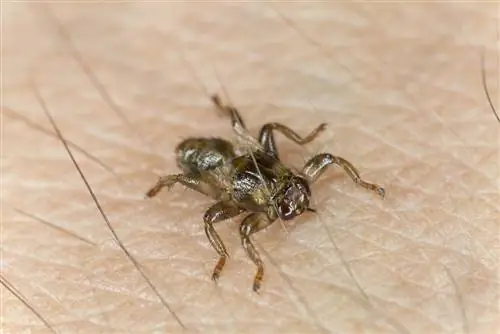
The deer louse fly has not been around here for long
As a result of global warming, the dark deer louse fly (Lipoptena cervi) is on the rise and is primarily causing significant headaches for dog owners. The black insect is tiny, 3-5 mm long, and at first glance resembles a small beetle or tick with wings. Deer, roe deer, horses and loose dogs are flown in. The beasts bite into the skin and suck blood.
How can you prevent small black beetles in the apartment?
Fly screens on windows, patio and balcony doors are an effective prevention against flying black beetles. Material pests, such as fur beetles, often enter the home via used goods. Avoid buying second-hand clothing or take the textiles to the dry cleaner immediately after purchasing them. Pantry pests get into the kitchen and pantry as stowaways from food packaging. Immediately transfer food to glass and plastic containers or freeze the food.
Tip
The good news is: little black beetles don't bite or sting. If you are tormented by tiny insects in bed, bed bugs or fleas are the culprits. You can read here how you can accurately identify and successfully combat the infamous pest.


